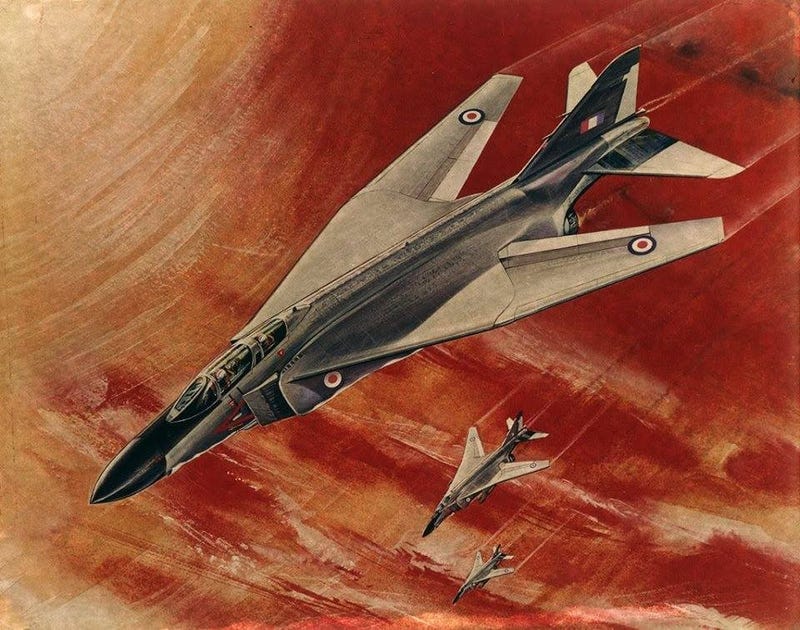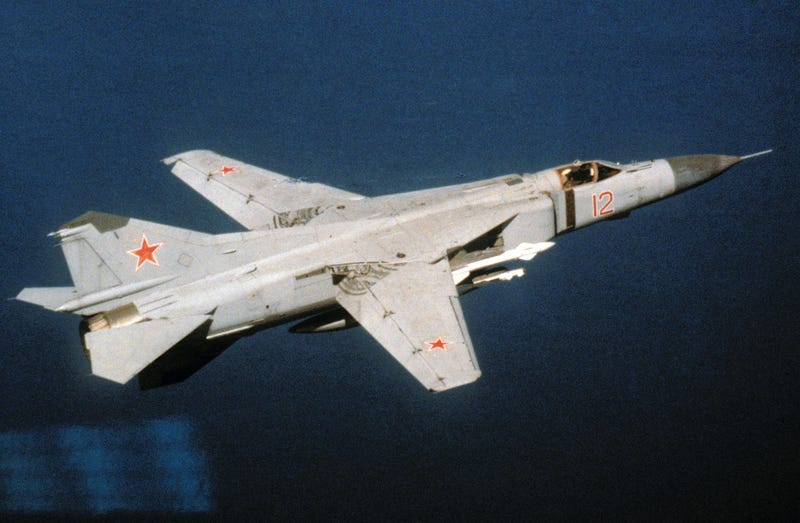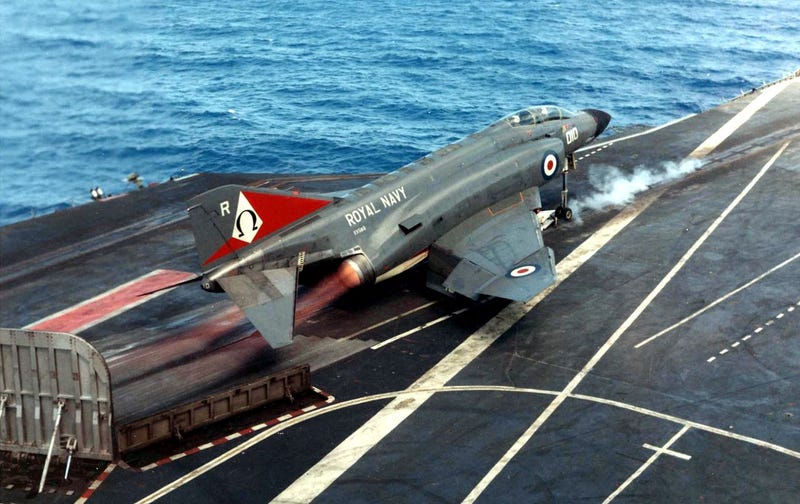
Posted on 10/18/2015 10:01:12 PM PDT by sukhoi-30mki

McDonnell Aircraft Corporation’s F-4 Phantom was quickly becoming the do-all fighter by the mid 1960s, able to lug thousands of pounds of bombs on one mission and then strictly air-to-air missiles the next. The potential for evolving the already successful Phantom became especially attractive as high-end combat aircraft programs of the ‘60s began to sputter, namely the Navy’s F-111B. Enter the F-4(FV)S variable-geometry wing Phantom concept.

The F-4(FV)S concept took the F-4 fuselage and omitted its low, bent-wing configuration. In its place was a redesigned highly-mounted swing-wing mated to large wing-root extensions. Within these extensions were the pivot points for the swing-wings. The result was a design that looked more like what would become the Soviet MiG-23 Flogger than anything else (see conceptual cutaway of the F-4(FV)S here).

Like the General Dynamics F-111 in development at the time, the F-4(FV)S’ variable geometry wing, able to sweep between 23 and 75.5 degrees, would have given the F-4 blistering high-speed performance, while also allowing for improved low-speed handling.
This configuration could have solved what was a a trade-off in the Phantom’s evolving wing design. Up until the F-4E and the F-4S, the F-4 had a “hard wing” with no leading-edge maneuvering slats to enhance its agility and slow-speed handling. This configuration was fine for pure interceptor or reconnaissance missions as it offered a wing that was optimized for high-speed flight, but for dogfighting, hard maneuvering trying to avoid enemy ground fire and surface-to-air missiles, and flying around the carrier, it was far from ideal.
By employing a variable geometry wing, the Phantom could be more aerodynamic than ever before at high speed and more responsive at low speed. This could all be had without the F-4E and F-4J’s “improved wing” that did induce a high-speed performance penalty.
In addition to a new high, swing-wing arrangement, other changes were made on F-4(FV)S concept, including improved fuel capacity, a modified tail and a new main landing gear arrangement. Even updated engines were discussed as part of the new configuration — ones with better fuel efficiency than the standard General Electric J79 axial-flow turbojet still found in Phantoms flying today.
Although the Navy did not bite at the swing-wing Phantom idea, McDonnell, which became McDonnell Douglas in 1967, kept revamping the concept. The main problem was that the Navy was looking for a Fleet Defender aircraft capable of lugging the massive AWG-9 radar and AIM-54 Phoenix missiles, something the Phantom just couldn’t be adapted to do. Instead, it would be restricted to the less capable AWG-10 radar and the latest version of the AIM-7 Sparrow, both which had a fraction of the range of the AWG-9 and Phoenix combination. The upside was it would be far less expensive than larger, more complex options.
A swing-wing fighter-interceptor solution eventually would be found for the Navy’s Fleet Defender dreams, developed under the VFX program. That aircraft being Grumman’s outgrowth production version of their 303E concept, the F-14A Tomcat. McDonnell Douglas also put forward their model 225, of which a swing-wing variant was possible although it was passed over for the Grumman design.
Even though the swing-wing Phantom may not have been right for the U.S. Navy’s needs, the Royal Navy and Royal Air Force was another possible suitor. For the Royal Navy, McDonnell proposed the F-4J(FV)S. It would feature increased fuel, a new tail design, the AWG-10 radar and AIM-7F Sparrows with simultaneous multi-engagement capability, and a variable geometry wing with a sweep of 19 degrees to 70 degrees and full-span flaps and spoilers along its trailing edge. It would also have a pair of more powerful and fuel efficient Rolls-Royce Spey turbofans.

The Royal Air Force was offered a similar aircraft under the designation F-4M(FV)S that would work for their land-based strike-fighter needs. Both designs kept high commonality with the original Phantom design for ease of transition and maintenance.
In the end, the updated swing-wing Phantom did not represent a large enough leap in capability for the UK to take the risk on procuring it. Additionally, the Anglo-French AFVG project in its early stages, and proceeding with a swing-wing Phantom would have endangered it. With the Navy also going in a more advanced direction, the variable geometry F-4 Phantom would never take flight.
Credit: DoD for photos, concept art and line drawings McDonnell/Industry
Sources: Hushkit.net, Aerospaceprojectsreview.com
...and considerably smaller than a Midway.
********************************
I served on the FDR, a sister ship to the Midway and Coral Sea. Flight deck was over 900 ft., but the cat shot was only 180 ft. Four AG wires probably were about 400 ft. of deck (just a guess, as I was in Cats).
I was in Civil Air Patrol as a kid. lots of the local meetings/gatherings of squadrons took place at Selfridge ANGB. I saw and heard a lot of them as a teenager. And you’re right, they are LOUD!
CC
Doorgunner69,
No doubt Kelly Johnson did have a few of those. I was just making a joke about what the sketch of the “swing-wing F-4” looked like in the article. I doubt this was ever a serious option. (Interesting, the FB-111 [THX?]and the F-14 Tomcat were intended to share numerous design features and assemblies. In the end, the wing pivot was the only shared piece.)
I think history will confirm your suspicion about a number of successful designs, though. The P-51, especially in its first phases, and later when the Merlin was added, really was the outgrowth of informal musings. No doubt intoxicating spirits were at least in the vicinity LOL!.
Oldplayer
There was also an F-4L on the drawing board that was supposed to be able to operate from the light carriers. I suspect that such a design would have been limited to an air to air load out.
It would have been interesting to see a Buccaneer operate from an Essex class. Some would debate that the Buccaneer was a better airframe than the Intruder.
Semper Fi
I was bringing a patrol back to our company base when we were attacked from both sides of a ridge. Called for air support and was sent a Phantom, pilot approached asked for smoke on our position. He laid some napalm eggs on the side of the ridge he was approaching then flew right past our heads did a back flip (?) a barrel roll and laid eggs on the other side of the ridge. We made it to the perimeter without a casualty, could have kissed the pilot right then.
What? Speak up, I can’t hear you!
I was in the USAF for 22 years.
I can understand. My best design ideas used to come while I was shaving. It's a mindless task, and gives your brain a chance to free-wheel.
I as with Navy Squadron VF-96 and we first had the F4-B and then the F4-J. I can attest to the loudness as my hearing deteriorated.
One of my faves.. Those babies could haul a load , take hits and make it home more than most aircraft of that era.. And could they belch ‘pollutants’ when ya kicked the afterburners in.. Loud? Good!

The F-14A shared engines, Phoenix missile and Radar suite with the cancelled F-111B. Those are the “prime cuts” of any aircraft program.
Disclaimer: Opinions posted on Free Republic are those of the individual posters and do not necessarily represent the opinion of Free Republic or its management. All materials posted herein are protected by copyright law and the exemption for fair use of copyrighted works.